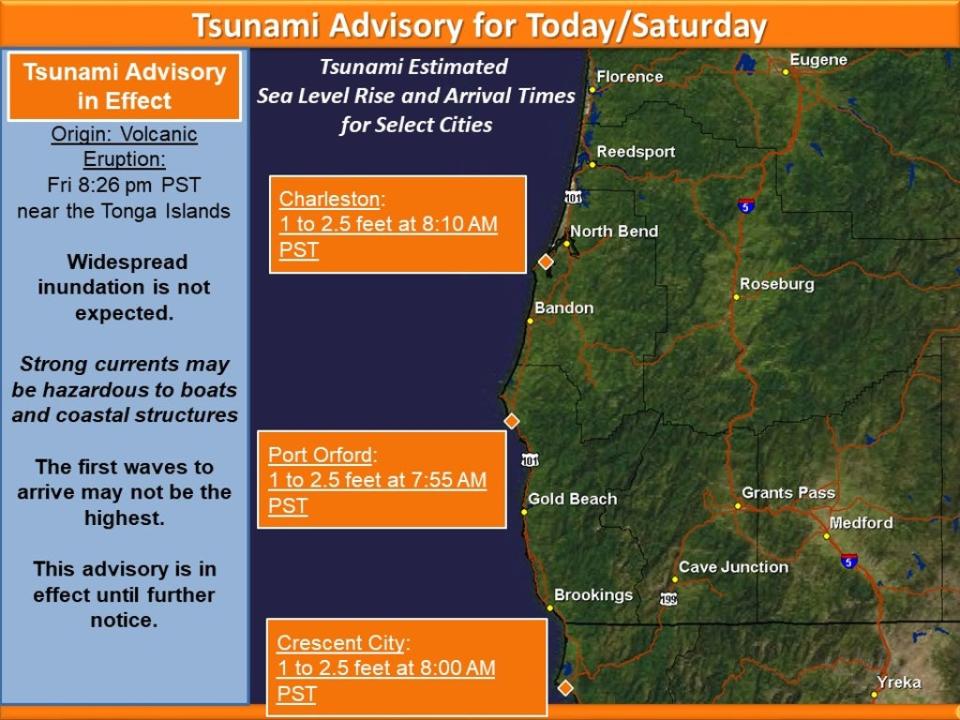Tonga hit by tsunami as Australia, New Zealand and US issue alerts after huge volcanic eruption
An undersea volcano has erupted in the Pacific island nation of Tonga, sending large waves which prompted tsunami advisories across the South Pacific and the US.
People have been forced to flee their homes, streets and buildings have flooded, as tsunami waves crashed into Tonga’s main island of Tongatapu.
A tsunami advisory has now been issued for the west coast of the United States National Weather Service's National Tsunami Warning Center has confirmed.
The alert covers areas stretching from southern California to Alaska and has also warned of 1 to 3 ft waves along the Washington and Oregon Coast.
An advisory means that strong currents and dangerous waves are imminent and people should stay out of the water.

New Zealand’s emergency management agency issued an advisory on tsunami activity for its north and east coasts stating that some parts of the nation could expect “strong and unusual currents and unpredictable surges at the shore following a large volcanic eruption”.
Meanwhile, New Zealand’s military said it was monitoring the situation and remained on standby, ready to assist if asked.
So far there have been no immediate reports of injuries or deaths in Tonga or elsewhere.
The eruption of Hunga Tonga Hunga Ha'apai, located about 65 kilometres north of Nuku'alofa, caused a tsunami measuring 1.2 metres, Australia's Bureau of Meteorology said.
Australia’s federal government is also “monitoring the situation” and “ready to provide support to Tonga if requested”.
The Tonga Meteorological Services said a tsunami warning had been put in force for all of Tonga and data from the Pacific Tsunami Warning Center showed waves of 80 centimeters (2.6 feet) had been detected.
Authorities in the nearby island nations of Fiji and Samoa also issued warnings, telling people to avoid the shoreline due to strong currents and dangerous waves. The Japan Meteorological Agency said there may be a slight swelling of the water along the Japanese coasts, but it is not expected to cause any damage.
Tsunami waves measuring two feet in height were also generated in American Samoa after the volcanic eruption.
In a statement, the Pacific Tsunami Warning Centre in Honolulu said that “a tsunami was generated by this earthquake. And based on all available data, there is a threat to American Samoa of sea-level fluctuations and strong ocean currents that could be a hazard along beaches, in harbours and in coastal waters.”
Tonga’s Business news site reported that a convoy of police and military troops evacuated the island’s King Tupou VI from his palace near the shore. He was among the many people who headed for higher ground.
Stay safe everyone 🇹🇴 pic.twitter.com/OhrrxJmXAW
— Dr Faka’iloatonga Taumoefolau (@sakakimoana) January 15, 2022
Dr Emily Lane from New Zealand’s National Institute of Water and Atmospheric Research said the eruption is “very significant.”
Professor Shane Cronin, School of Environment, University of Auckland, added that the eruption is one of the volcano’s largest since 1100 AD and warned that the people of Tonga should be vigilant of further eruptions of the same size.
“The past large Hunga eruptions were comparable to the scale that we have seen in the 15 January 2022 event or larger. Based on these past events, tephra (ash) falls of up to 20 cm thick can be expected on Tongatapu and the Ha'apai group of islands. Geological deposits on Hunga Ha’apai of the AD1000 and AD200 eruptions suggest that there were many eruptive phases during each of the major eruption episodes,” Professor Cronin said.
He added: “This suggests that the current eruption episode could last several weeks or months and that further similar sized eruptions to the 15 January 2022 event are possible.”
A Twitter user identified as Dr. Faka’iloatonga Taumoefolau posted video showing waves crashing ashore.“Can literally hear the volcano eruption, sounds pretty violent,” he wrote, adding in a later post: “Raining ash and tiny pebbles, darkness blanketing the sky.”
The volcano is located about 64 kilometers (40 miles) north of the capital, Nuku’alofa. Back in late 2014 and early 2015, a series of eruptions in the area created a small new island and disrupted international air travel to the Pacific archipelago for several days.

